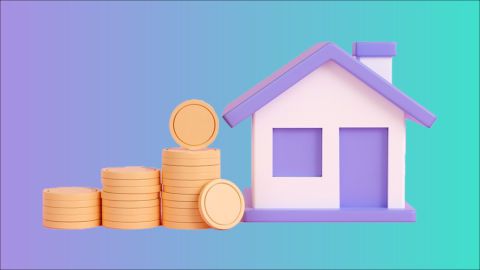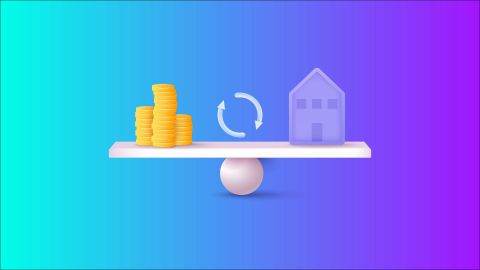For many Indians, purchasing a home is a significant milestone and a long-term financial commitment. In the process of acquiring a home, one encounters various financial terms, with "principal" and "interest" being two crucial components of a home loan. Read on to know more about home loan principal amount and interest.
Home loan
A home loan, also known as a housing loan, is a sum of money borrowed from a financial institution to purchase or refinance a home. Home loans come with repayment plans, typically spread over several years. During this repayment period, borrowers need to repay the principal amount and the interest charged by the lender.
Understanding home loan principal amount
The principal amount is the initial loan amount borrowed to buy the property. This is the actual cost of the home that the borrower agrees to pay back to the lender over the loan tenure. Let us take an example:
Suppose you take a home loan of Rs. 50 lakh to buy your dream home. In this case, Rs. 50 lakh is the principal amount.
Repayment of principal
The repayment of the principal amount usually follows an EMI structure. An EMI is a fixed payment amount made by the borrower to the lender on a specific date each calendar month. A part of this EMI goes towards repaying the principal amount.
For instance, if your monthly EMI is Rs. 40,000, and Rs. 15,000 of it goes towards the principal, the remaining Rs. 25,000 is allocated to interest payment.
Understanding interest
Interest is the cost of borrowing money and is the lender's compensation for providing the funds. It is calculated as a percentage of the outstanding principal amount. The interest component of the EMI decreases over time as the outstanding principal reduces.
Here is an example, if the annual interest rate on your home loan is 8%, the monthly interest payable would be (8% of Rs. 50 lakh)/12 months, which equal Rs. 33,333 for the first month.
Repayment of interest
In the initial years of the home loan, a significant portion of the EMI goes towards paying interest. However, as the loan tenure progresses, a larger portion is dedicated to repaying the principal. This is known as an amortisation schedule.
Continuing with the example, as the outstanding principal decreases, the interest component of the EMI decreases, and the principal repayment increases. By the end of the loan tenure, most of the EMI contributes to repaying the principal.
How do you calculate home loan principal amount?
To calculate the home loan principal amount, you need to use a simple formula:
Principal Amount = Total Loan Amount - Total Interest Payable
The total loan amount is the amount borrowed from a bank or financial institution, while the total interest payable is the total amount you will pay in interest over the loan's tenure. Hence, subtracting the total interest payable from the total loan amount will give you the principal amount you will repay over the loan's tenure. This calculation can help in optimising your home loan tenure, EMI amount, and down payment.
Home loan tax benefits
In India, home buyers can avail themselves of several tax benefits on home loans. These benefits are designed to encourage homeownership and provide financial relief to individuals undertaking the significant financial commitment of buying a house. Here is an overview of the key tax benefits associated with home loans in India:
1. Section 24(b) - Interest on home loan
- Under Section 24(b) of the Income Tax Act, the interest paid on a home loan is eligible for deduction.
- For a self-occupied property, the maximum deduction allowed is Rs. 2 lakh per annum. This limit is applicable from the financial year 2014-15 onwards.
- In the case of a property that is not self-occupied (rented out or deemed to be let out), there is no upper limit on the interest deduction. The entire interest paid can be claimed as a deduction.
Example: Suppose you pay Rs. 4 lakh as interest on your home loan during the financial year. If the property is self-occupied, you can claim a deduction of Rs. 2 lakh under Section 24(b). If it is let out, the entire Rs. 4 lakh can be claimed as a deduction.
2. Section 80C - Principal repayment
- Principal repayment of the home loan is eligible for deduction under Section 80C of the Income Tax Act.
- The maximum limit for this deduction is Rs. 1.5 lakh, which includes other investments like PPF, NSC, etc.
- This deduction is available for the repayment of the principal amount, stamp duty, and registration charges.
Example: If your annual principal repayment is Rs. 1.2 lakh, you can claim the entire amount as a deduction under Section 80C.
3. Section 80EEA - Additional deduction on interest
Section 80EEA provides an additional deduction of up to Rs. 1.5 lakh on the interest paid on a home loan.
This deduction is available to first-time home buyers for loans sanctioned between April 1, 2019, and March 31, 2023.
The stamp duty value of the property should not exceed Rs. 45 lakh, and the taxpayer should not own any residential house on the date of the loan sanction.
Example: If you qualify for Section 80EEA and pay Rs. 3.5 lakh as interest, you can claim a total deduction of Rs. 4 lakh (Rs. 2 lakh under Section 24(b) and Rs. 1.5 lakh under Section 80EEA).
4. Joint home loan benefits
- If you have taken a joint home loan with family members, each co-applicant can individually claim deductions on both the interest and principal repayment.
Example: In a joint home loan with your spouse, both you and your spouse can claim deductions on the interest and principal repayments separately.
It is essential for homeowners to keep all relevant documents, such as loan statements, possession letters, and completion certificates, to claim these deductions accurately. Additionally, tax laws are subject to amendments, so it is advisable to stay updated on any changes that may impact these benefits. Consulting with a tax professional or financial adviser can provide personalised guidance based on individual circumstances.




